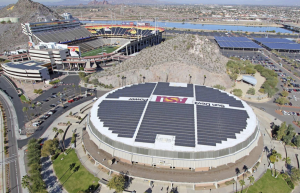While intended to be a rating system to show “green-ness”, RoofPoint is also a design guide for roof systems. Following the tenets in RoofPoint and achieving RoofPoint certification likely means a roof was well-designed, -installed and -maintained with good materials. Therefore, an energy-efficient, long-lasting, high-performance roof will be the end result.
The RoofPoint Energy and Carbon Calculator is a useful tool to show how a RoofPoint roof can save money relative to an older, less energy-efficient roof. It also can model energy savings— comparing a new/proposed roof to the existing. Overall energy savings, peak-energy savings and CO2 offsets are calculated to allow thorough analysis of the energy benefits.

WELLS FARGO ARENA, TEMPE, ARIZ., features a RoofPoint-certified white, reflective membrane from Sika Sarnafil that will decrease heat flow through the roof system. More than 2,000 photovoltaic panels from Kyocera Solar Inc. will produce an estimated 800,000 kWh annually.
And, just recently, the center announced the RoofPoint Registered Professional (RRP) program. Roofing professionals can become RRPs to show their fluency in the RoofPoint program. Importantly, RRPs can submit and certify that a roof meets the requirements of the RoofPoint program.
PV AND ADVOCACY
The center leads and participates in many additional activities beyond its RoofPoint program. For example, it is active in the rooftop photovoltaic industry, promoting long-term performance of rooftop solar. The center’s PV Taskforce, comprised of center members, developed guidelines for integrating PV into a rooftop, specifically buildings with low-slope roofs. “PV Racking and Attachment Criteria for Effective Low-slope Roof System Integration” provides high-level discussion about issues and solutions relevant to the many ways PV systems are installed on asphaltic, single-ply and spray-foam rooftops. Additionally, “PV Racking and Attachment Criteria for Effective Low-slope Metal Panel Roof System Integration” provides a similar, yet unique, discussion about structural metal panel roof systems.
Finally, the center is a constant advocate for environmentally friendly roofs, working with codes and standards groups, governmental groups and NGOs, building owners and facility managers, as well as with all participants within the roofing industry, promoting sustainable roofs through the advancement of the RoofPoint program. CEIR advocates for sustainable roofing; the roadmap is RoofPoint.
PHOTOS: Center for Environmental Innovation in Roofing
Learn More and Become Involved
Center for Environmental Innovation in Roofing
RoofPoint and RoofPoint Registered Professional programs
RoofPoint Energy and Carbon Calculator
Center PV Taskforce


Be the first to comment on "A Trade Association Brings Roofs to the Sustainability Discussion"